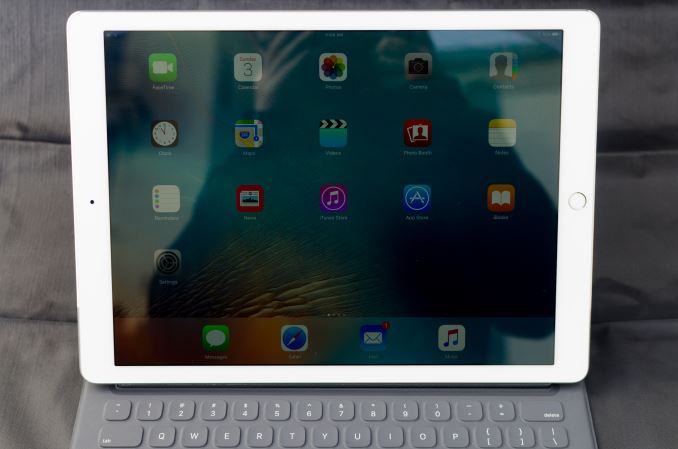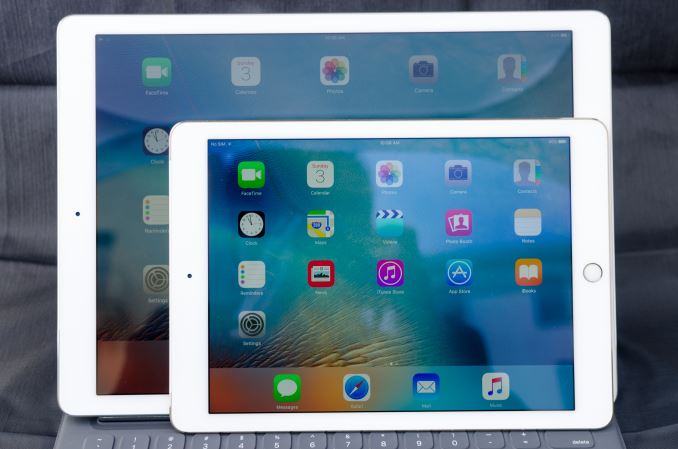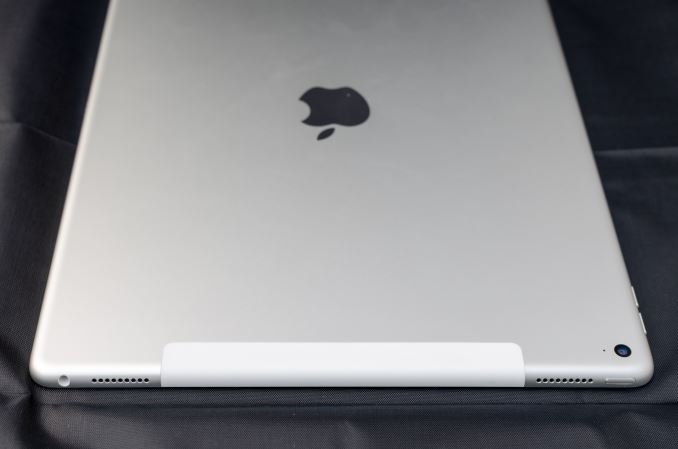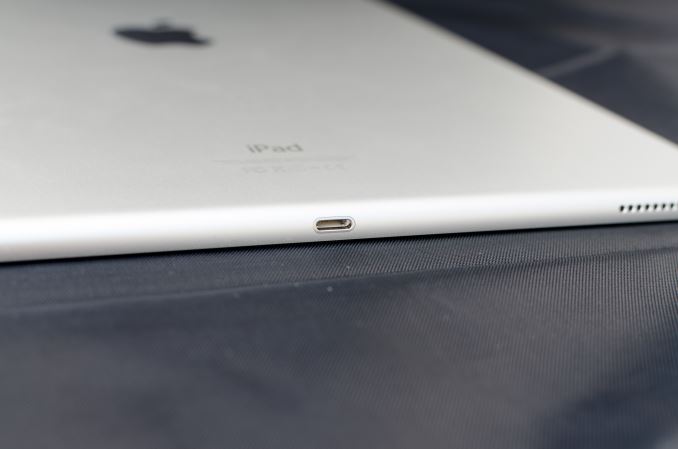The Apple iPad Pro Review
by Ryan Smith, Joshua Ho & Brandon Chester on January 22, 2016 8:10 AM EST
At this point it probably isn’t a secret that tablet sales have leveled off, and in some cases they have declined. Pretty much anywhere you care to look you’ll see evidence that the tablet market just isn’t as strong as it once was. It’s undeniable that touch-only tablets have utility, but it seems that the broader market has been rather lukewarm about tablets. I suspect at least part of the problem here is that the rise of the phablet has supplanted small tablets. Large tablets are nice to have, but almost feel like a luxury good when they’re about as portable as an ultrabook. While a compact laptop can’t easily be used while standing, or any number of other situations where a tablet is going to be better, a compact laptop can do pretty much anything a touch-only tablet can. A laptop is also going to be clearly superior for a significant number of cases, such as typing or precise pointing.
As a result, large touch-only tablets feel like they’ve been limited to home use as a computer away from the computer. Tablets are great when you’re on the couch or in bed, but once you get to this point there are some obvious questions as to whether it makes sense to drop $500+ USD on a tablet that seems to have relatively limited utility. The Surface lineup has been showing signs of growth, but in general the Surface is more of a mix between laptop and tablet rather than a tablet. I would argue that given the OS and overall design that the Surface and Surface Pro are really more laptop than tablet, even if at the hardware level the Surface Pro 4 and Surface 3 are basically tablets with kickstands and keyboard covers.
If you’re guessing that this means Apple has had some issues with growing sales of their iPad lineup, you’d be right. From my first experiences with the iPad 3, I was impressed with the improved user experience for things like web browsing and other smartphone tasks, but I never really felt like it made enough sense to get one for myself. The iPad Air 2 was once again impressive and I felt like I could recommend it to other people that wanted a tablet, but I personally struggled to come up with a reason why I would buy it.
This brings us to the iPad Pro. This is probably the first time Apple has seriously deviated from traditional iPad launches, putting together a tablet built for (limited) productivity and content creation rather than just simple content consumption, creating what's arguably the iPad answer to the Surface Pro. To accomplish this, Apple has increased the display size to something closer to that of a laptop, and we see the addition of a stylus and a keyboard cover for additional precision inputs. Of course, under the hood there have been a lot of changes as well, so the usual spec sheet can be found below to summarize those changes.
| Apple iPad Air 2 | Apple iPad Pro | |
| SoC | Apple A8X 3 x Apple Typhoon @ 1.5GHz |
Apple A9X 2 x Apple Twister @ 2.2GHz |
| GPU | PowerVR 8 Cluster Series6XT (Apple GXA6850) |
PowerVR 12 Cluster Series7XT |
| RAM | 2GB LPDDR3 | 4GB LPDDR4 |
| NAND | 16/64/128GB | 32/128GB |
| Display | 9.7" 2048x1536 IPS LCD | 12.9" 2732x2048 IPS LCD |
| Size and Mass | 240 x 169.5 x 6.1mm 437g WiFi, 444g LTE |
305.7 x 220.6 x 6.9 mm 713g WiFi, 723g LTE |
| Camera | 8MP Rear-Facing, f/2.4, 1.1 micron, 1.2MP Front-Facing, f/2.2 | |
| Battery | 27.3Wh | 38.5Wh |
| Launch OS | iOS 8 | iOS 9 |
| Cellular Connectivity | MDM9x25 Category 4 LTE + GPS/GNSS in Cellular SKU | |
| Other Connectivity | 2x2 802.11a/b/g/n/ac + BT 4.2, Apple Lightning | |
| SIM | Optional NanoSIM | |
| Price | $499/599/699 16/64/128GB | $799/949/1079 32/128GB/128GB LTE |
At a high level, the iPad Pro gains a larger display with a higher resolution, more memory, a new SoC, and a larger battery to compensate for the change in display size. In addition to these changes, the iPad Pro also brings noticeable changes to the speakers, with an increase to four speakers which allow the iPad Pro to compensate for device orientation when projecting stereo audio.
Design
The most immediate change that you can see in the iPad Pro is the sheer size. The 12.9” display of the iPad Pro basically makes it feel like you’re carrying a laptop around. I would argue that this doesn’t actually affect the portability of the iPad Pro, but this is mostly because the iPad Air 2 was something that I only carried in a backpack to begin with. People carrying their tablets in a small bag, purse, or even just in their hands will notice the difference, so the change in size might be more or less noticeable depending upon how you carry things around.
The increase in size does affect weight. After significant use, I honestly don’t think the mass is a significant issue. It does feel heavier than the iPad Air 2, but the mass distribution is such that there isn’t a ton of battery hanging out at the edges of the device where it’ll affect the moment of inertia. This does raise the question of whether Apple included enough battery for sufficient battery life, but that’s a question best left for the rest of the review.
In terms of design, the iPad Pro is rather unremarkable if you’ve ever seen an iPad Air before; it is for all intents and purposes a bigger iPad Air. On the front, the display dominates, with some bezels on the sides and top. The top has the front-facing camera, and the bottom has the home button with TouchID.
Looking at the sides of the tablet, the top edge has the power button and 3.5mm port, along with two of the four speakers. The right edge has the volume buttons, and the bottom edge has the Lightning port and the other two speakers. The left edge is mostly empty, but contains the Smart Connector for the Smart Keyboard and similar accessories.
The back of the tablet is mostly unremarkable as well. For the LTE model, an RF window is visible on the top of the device to allow LTE and other connectivity to function. For the WiFi variants, it looks like the bottom display bezel and the bottom two speakers are the RF windows, so there aren’t any visible areas that indicate where the WiFi antennas are.
Overall, the iPad Pro feels like an iPad, with nothing all that remarkable beyond its size which is carried well. I never really noticed the mass or size of the iPad Pro even if it is clearly larger and heavier than the iPad Air 2. I also didn’t notice any issues with the back cover flexing, but given enough pressure on the back cover pretty much any device this large will see some screen distortion or bending. The iPad Pro does technically regress in thickness compared to the iPad Air 2, but I never noticed the difference in practice, especially when the larger display is really what matters more.
















408 Comments
View All Comments
jimjamjamie - Friday, January 22, 2016 - link
As per the review, Intel's chips are on a more advanced process, which was born from research they had to foot the bill for. It was clearly worth it too since the Core chips are better-performing.lilmoe - Friday, January 22, 2016 - link
This doesn't justify Intel trying to get a return on investment from the first batch....lilmoe - Friday, January 22, 2016 - link
This might backfire on me but I'll say it again.This is why Windows RT was the BEST OS to address that problem. The OS can run, natively, on practically any platform if Microsoft wanted to. I seriously believe Intel had a LOT to do with that perception (Google too, of course).
People ignorantly shunned the concept of RT without fully knowing the implications. If it succeeded, it would have made HUGE pressure on Intel to up their game. Good thing Microsoft is back with Unviersal Apps. I seriously hope they succeed and the new platform takes off. If it does, these same apps can run on Windows 10 Mobile, which can theoretically run a full fledged desktop environment (other than continuum).
This will make an explosion in processor and SoC competition, where the consumer wins.
The Hardcard - Friday, January 22, 2016 - link
Apple is in the best position to seize the future. There is not going to be an ARM OS X, nor will Apple merge. Apple will maintain the split approach until iOS hits a critical point and then OS X will go. I predict new OS X versions will cease inside of ten years. There will be software for iOS that will do everything needed to be done.Sure, many of the people currently on these tech sites will not like how the new software works and will be very vocal about how they can only get real work done on legacy software with a legacy OS. But Apple sees that you are getting older and closer to your final resting place.
Young people, the future buyers of all tech, don't have legacy attachments. They will do their real work on the new tech.
I walked up to a young guard who was blasting away messages at astonishingly high speed on her Android phone with her thumbs, faster than I could ever type. When she needed to use a "real" computer to check me in, it took her forever to peck out a few bits of information on the keyboard.
It was clear that whenever given the choice of new tech, new software, and new ways that is what she will choose. Which is why Microsoft's devices and OS that can also do real work is useful now, but will soon become a disadvantage. The up and coming workforce in 2025 are going to want devices without the legacy cruft.
The Hardcard - Friday, January 22, 2016 - link
I meant to say Google also. Android will also develop pro capabilities on powerful new devices without worrying about supporting "real" software for guys that will be retired and fishing inside of 20 years.id4andrei - Friday, January 22, 2016 - link
That is your wishful thinking so far. I am saying wishful since the market has rewarded the ipad with shrinking numbers.MaxIT - Saturday, February 13, 2016 - link
Ever heard the word "saturation " ? There isn't anything eating up iPad market. The Surface Pro isn't even a credible contender. The tablet market is just saturated because people don't replace their tablets every year or two like the smartphones...royalcrown - Sunday, January 31, 2016 - link
I disagree, I think OSX wil' stay as long as there are macs, be it Imacs or Mac pros.simard57 - Friday, January 22, 2016 - link
it would seem the lack of ink to text is a fail that Apple has to address. How else will ink be searched unless it is OCRed into a document?JoshHo - Friday, January 22, 2016 - link
OCR supposedly works with Spotlight search. However in practice if you want ink to text I found that it is necessary to do the conversion by syncing to Windows x86 OneNote and doing the conversion on that platform, which is a rather suboptimal workflow.